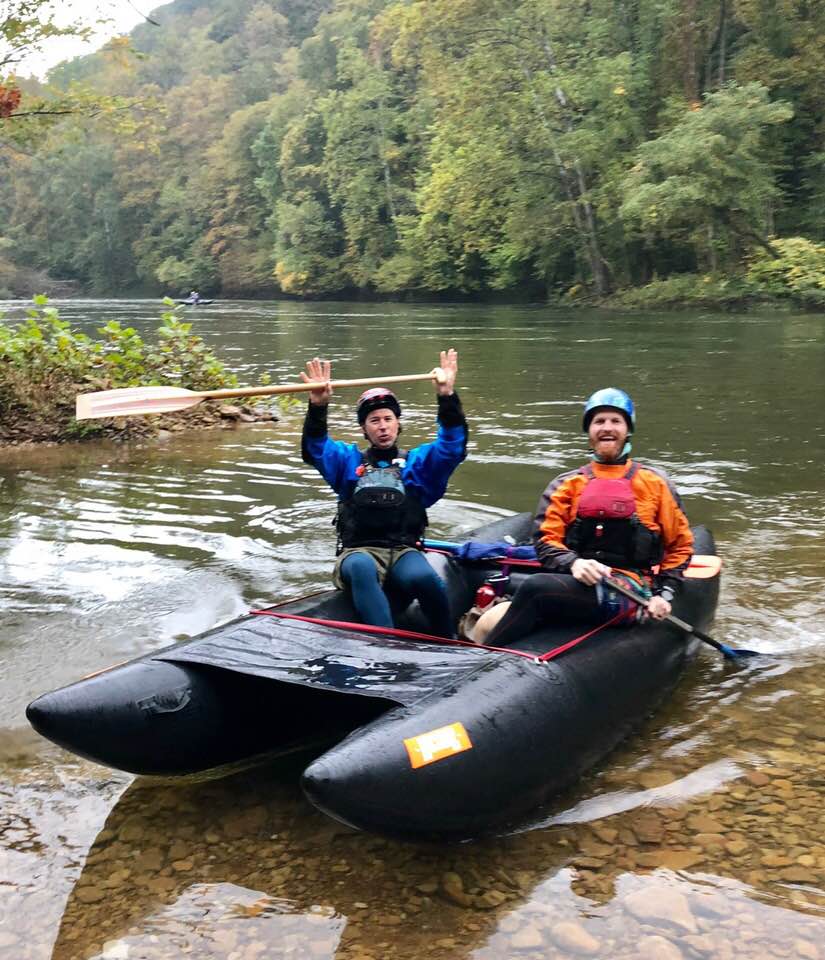by Vance R. Parker JD, MBA | Nov 29, 2020

The author kayaking Pillow Rock rapid on the Upper Gauley river, October 10, 2020.
Now almost 58 years old, I had last kayaked West Virginia’s Upper Gauley river (American Whitewater Class IV-5.0 difficulty rating) in my early 40s. Prior to this year, I had been away from whitewater kayaking 10 years. With boater friends one mist-shrouded morning this last October, I became one with the water again thundering down Gauley gorge.
During “Gauley Season” each fall, the Army Corps of Engineers lowers Summersville Lake on consecutive weekends, opening the outflow tube at Summersville Dam. Newly free epic whitewater charges downriver, as it has for eons. Gauley Season attracts whitewater boaters from all over the United States, with American Whitewater’s colorful Gauley Fest whitewater festival (postponed this year due to COVID-19) rowdily celebrating everything whitewater.
Although the Upper, Middle, and Lower Gauley are physically challenging runs, one notices silver-haired paddlers mixing in with the young pups, eager to run “Insignificant” or “Pure Screaming Hell” rapid one more time. When I was younger, one of our favorite whitewater companions paddled the Upper into his ’80s, always with a big smile on his face.
In our elder law practice a few years ago, my wife Karen and I started noticing that some of our clients we were helping qualify for assisted living admissions were our own ages, or younger, with many of these folks suffering from avoidable illnesses. Without a healthy diet and without enough exercise, our clients had become more susceptible to diabetes, heart disease, or stroke. For clients wanting to “age in place” in their own homes, those who had put on too much weight now had to enter assisted living instead, because their family caregivers were no longer strong enough to help them safely out of bed, or up from a chair. These clients now required the specialized lifts and extra staff attendants that an assisted living facility could provide.
These observations helped motivate me to get back in shape myself. I joined a Crossfit gym, started making healthier food choices, and lost quite a few pounds as I become ready to tackle the Upper Gauley once again.
Vance Parker Law supports healthy aging. I hope that you enjoy my Upper Gauley whitewater video, and that you will get outdoors yourself whenever you can, to create your own healthy adventures…
CLICK THIS TEXT LINK HERE TO WATCH MY RUNNING THE BIG WATER UPPER GAULEY RIVER VIDEO

The author paddling through the froth at Pillow Rock rapid, working to stay “on line.”

Whitewater friends paddling to the Lower Gauley takeout, after completing the 26+ Gauley marathon run (Upper, Middle, and Lower sections), with over 100 Class III to Class 5.0 rapids, on October 10, 2020.
by Vance R. Parker JD, MBA | Jun 10, 2019

From my earliest memory, my family lived near the water, and as a young boy, I wanted to be just like my dad. How wise he was—how could he know so many things? We always had a small powerboat, and, from the time I was little, my dad was always teaching me how to use it. The ways of the sea, so to speak.
Ropes and knots are a fundamental part of boating lore and safety. The variety of knots that mariners learned time and again from their own dads vary in form and purpose, and are elegantly spare in design. My father taught me to tie knots from the time I can remember being old enough to hold a fishing pole.
In a way, becoming a man used to be a lot simpler. The father spent time with his child, dispensing wisdom slowly, one nugget as a time. The child, a boy in my case, wanted to learn everything.
How do you tie an anchor line? I remember my dad telling me, “that knot can’t slip, son!” He showed me the knot to use to hold the anchor firm. “If the knot slips out, son, the anchor might be lost, and the boat set adrift. The boat could drift into rocks, and crash against them. While the boat is at anchor during the night, if the anchor knot slips, the whole boat can drift away, never to be found again.”
When mooring a boat to a dock, I learned the hard way that if you tie the wrong knot (particularly if the water is rough and the boat is heaving up and down), the heavy boat will repetitively jerk the knot so tight that you could never untie it. Instead, you had to cut the whole rope in two.
“Son, here is how you tie a mooring line to a dock post. If you just wrap the rope around the post several times first, the friction between the rope and the post will hold the boat firm when the swells load up the post. A very loose simple half hitch, easy to untie, is all that is then required to hold the whole assembly together.”
“Here is how you tie the mooring line to the cleat, son. Just a couple of loops around and back this way will do it, then run the last loop under the previous loop and loop it back over the cleat again, so the tension from the boat pulling against the post will hold the rope firm to the cleat, but the line will still be easy to remove when we are ready to go back out fishing…”
“Son, this is how you tie a blood knot to add a swivel when using slick monofilament line. You wrap a lot of loops around the long shaft of the main line, then thread the end back through the hole right above the top of the swivel eye… then tighten up the loops like this… Do you see how this looks like a hangman’s noose? Watch what happens when I wrap the line a few times around my finger, then hold the swivel like this [between my right thumb and index finger], and pull down hard. Do you see how the cinch loops only tighten, and the knot never gets looser? If you tie your blood knot like this, you are not going to lose your fish, no matter how hard he pulls!”
My dad, still young in his 20s back then, was an able teacher, but I didn’t fully understand how wise he was until I was much older. I learned later that at the time that my dad was first teaching me knots, he was driving his little, tan VW Beetle from our West Palm Beach, Florida home far into the Everglades. Deep in the swamp, he was testing powerful prototype SR-71 Blackbird spy plane engines as a mechanical engineer for Pratt & Whitney Aircraft, at its top secret test facility. “We tested those engines outside on test stands” my dad later told me, “where only the alligators and 5 inch wide rattlesnakes could hear. The shock waves were so powerful, they felt like a man beating you in the chest.”
I think all of those engineers and scientists in the SR-71 spy plane program back then intuitively appreciated knots that would hold fast, and would not slip under load, because they were trying to hold fast an entire airframe as it was pushed to speeds never attempted before.
It was the middle of the Cold War, and Francis Gary Powers had been shot down over Russia in our country’s much slower U-2 spy plane. The engineers and scientists designing the SR-71 engine at Pratt & Whitney in Florida, together with those working on the fuselage in Lockheed Martin’s Skunk Works in Burbank, California, knew that they must now launch our flyboys high and fast, hold fast their ship through tremendous heat and pressure, then bring our boys home safely again.
And fly fast those boys did, at over three times the speed of sound, faster than a 30-06 rifle bullet. No SR-71 mission pilot was ever lost or shot down during this plane’s entire operating life.
As I grew older, those strong, steadfast knots I learned to tie early from my father became metaphors for the interwoven life lessons he later taught us by word and example: perseverance through stress… always protect those you love … practice makes perfect…
Fifty years after my dad taught me to tie those first knots, I found myself standing in Stokes County’s Dan River, rescue rope in hand. I had spent years whitewater kayaking with boaters in and around North Carolina, and had been invited to accompany some Sierra Club friends on their annual novice kayak trip down the Dan near Hanging Rock State Park.
One of the trip participants was having a very hard time that day, could barely walk with a hurt knee, and was very cold after successive spills into the river. I did not think that she could swim, at least I had not seen her attempt a stroke. She was sitting down shivering on a rock bar out in the river. A fast current cut off her route to shore, which was washing straight under a downed log, a mortal hazard that whitewater boaters call a “strainer.”
I readied myself to tie a “bowline” knot into my rescue rope, an open rescue loop which the rescue victim needed to put over her torso and under her arms, so we could pull her to safety. The bowline knot had to hold fast under load, and could not slip, because if it did so it could cinch down tight on the victim’s torso or neck, and asphyxiate her.
Although my father had not taught me how to tie the bowline, he had taught me the old way of ropes and knots, and I had everything I needed from him to be successful that day. I silently recited the “Rabbit Story” tool I used to remember how to tie the bowline: “construct the rabbit hole” … “the rabbit hops out of his hole” … “the rabbit hops around the tree” … “the rabbit hops back down his hole” … “the rabbit stops to watch the tree grow”…
The knot did hold fast that day under load, and did not slip. The old mariners’ wisdom had been passed on again, in a way as old as fathers and sons.
by Vance R. Parker JD, MBA | Mar 6, 2019

Elder and special needs, and estate planning attorney Vance Parker discusses why good elder caregiving begins in childhood, in his new opinion essay “Who Will Help Me to Age in Place,” published on March 5, 2019 in the Winston-Salem Journal.
To read Vance’s essay in the Journal, please click the following link:
https://www.journalnow.com/opinion/columnists/vance-r-parker-who-will-help-me-to-age-in/article_e1f935ae-3f75-11e9-942e-abc8a85ba074.html
by Vance R. Parker JD, MBA | Feb 13, 2019

WTOB FM/AM Radio in Winston-Salem, NC interviews elder, special needs, and estate planning attorney Vance Parker about how telephone scammers can hit anyone, even a retired FBI and CIA director and his wife. Vance concludes with basic tips for senior telephone and internet safety.
Vance talks with WTOB Radio every Tuesday at 4:38 pm, educating the public about elder and special needs law, and estate planning topics.
by Vance R. Parker JD, MBA | Jan 31, 2019

In the Jan 24, 2019 article “Scamming Grandma: Financial Abuse of Seniors Hits Record,” the Wall Street Journal states that U.S. banks reported a record 24,454 suspected cases of elder financial abuse to the Treasury Department last year, more than double the amount five years earlier. Although it is hard to obtain an exact figure because so much elder financial abuse goes unreported, the AARP frames elder financial abuse as a $40 billion to $50 billion problem within the U.S. Trusts can help.
The United States reports higher rates of elder financial abuse than other industrialized nations. In Europe, seniors’ retirement funds are mostly doled out to them gradually, in monthly payments from government or other pension funds, where they are used to pay monthly expenses. In the United States, because of insufficient monthly Social Security and pension payments, workers are encouraged to save a great deal of their retirement funds themselves, held in potentially large IRAs or other accounts which they control. In fact, according to the Wall Street Journal article and the American Bankers Association, people over 50 represent only one third of the population, but account for 61% of bank accounts, and 70% of bank deposits.
In the U.S., these large pots of money in the hands of seniors (who also exhibit higher rates of illness and cognitive decline) are irresistible to thieves–who can be local door to door scammers, local or long distance romance scam artists, household workers or care providers, nefarious family members, or international financial scam and con artists who reach seniors through telephones, computers, and cell phones. Recent scientific studies reported by the National Institutes of Health tell us that as brains age, they undergo physiological changes that diminish older people’s ability to identify threats and assess the trustworthiness of potential predators. Thieves, of course, discovered these weaknesses long ago.
An elder law or estate planning attorney can create a trust for a senior who is still competent, which figuratively creates a “vault” holding the seniors’ assets, and gives the vault key to a responsible family member or institution. Only this “trustee” can make financial transactions on the senior’s behalf. When predators, such as telephone scam artists, figure out that the senior does not have the key to the vault holding his or her assets, they often quickly lose interest in continuing the scam.
Trusts may also be set up much earlier in life, so that as long as the owner of the assets is mentally competent and not susceptible to predators, the asset owner can act as his or her own trustee and account manager. As the asset owner ages, a co-trustee may be added to help watch the accounts and help the account owner when needed. If the asset owner later becomes susceptible to financial abusers or is no longer mentally competent to manage assets, another responsible family member or an institutional corporate trustee may become sole trustee and manager of the senior’s accounts.
Because trusts may contain detailed, legally enforceable instructions for how a senior’s money is to be used, but financial or durable power of attorney documents typically do not, a trust may be a safer vehicle for managing a senior’s money than a power of attorney. In addition, trusts are more complex, and frequently put together in a lawyer’s office where the trustee can potentially be screened by the drafting attorney. A power of attorney document is often easily downloaded from the Internet, and used by a thief or dishonest family member very quickly, without an attorney’s involvement, to scam a senior.
As banks and financial institutions see higher rates of fraud with powers of attorney, and because trusts are often associated with more affluent clientele, a trustee managing a senior’s assets may be treated with more deference by financial institutions, and experience fewer hassles, than an agent on a power of attorney document.
An elder law or estate planning attorney can help a family determine if a trust is right for their needs.
by Vance R. Parker JD, MBA | Sep 12, 2017

CATEGORIES: Elder Law, Elder Care Attorney, Winston Salem, North Carolina, NC.
Given time, any brain can succumb to dementia — memories fade, thoughts scatter, basic abilities wither on the vine. Brains don’t come with lifetime guarantees, but there is one major step you can take to protect yourself from Alzheimer’s or other causes of mental decline: exercise your body. Nothing protects the brain quite like regular exercise, says Jennifer Heisz, a cognitive neuroscientist at McMaster University in Ontario, Canada. Not crossword puzzles, not supplements, not prescription medications. Exercise seems to beat them all, reducing the risk of Alzheimer’s disease or cognitive decline by about 35 percent to 45 percent, according to the latest evidence. People who don’t exercise as they age are taking a gamble. In a study of more than 1,600 older adults published in January in the Journal of Alzheimer’s Disease, Heisz and colleagues found that a lack of exercise was about as risky as having certain types of genes that raise the risk of Alzheimer’s. Genes are forever, but exercise habits can change.
Exercise enhances the release of chemicals known as nerve growth factors that help brain cells function properly, according to Teresa Liu-Ambrose, director of the Aging, Mobility and Cognitive Neuroscience Laboratory at the University of British Columbia. Nerve growth factors probably also help build new brain cells, giving the brain an extra cushion against age-related losses.
Studies in rodents show that exercise encourages formation of new brain cells in the hippocampus, an organ in the medial temporal lobe of the brain that plays an important role in memory.
“It’s like investing in a retirement fund for the brain,” Liu-Ambrose says. Exercise enhances blood flow to the brain, which can help keep it healthy and nourished. Liu-Ambrose notes that exercise also helps prevent hypertension and diabetes, which are two major risk factors for dementia.
There’s no particular type of exercise that seems to be best for the brain. Heisz notes that most of the subjects in her study walked three times a week. “It could be as simple as that,” she says. About 2.5 hours of moderate to vigorous aerobic exercise every week would be a reasonable goal, she says.
“Even a 15-minute walk per day would be much better than doing nothing at all,” Liu-Ambrose says. “People just need to do it.”
Sources:
National Academy of Elder Law Attorneys, (May 24, 2017).
Chris Woolston, Why exercise is the best medicine for your brain, Los Angeles Times (May 18, 2017),
by Vance R. Parker JD, MBA | Jul 27, 2017

CATEGORIES: Elder Law, Elder Care Attorney, Winston-Salem, North Carolina, NC.
For obese people over age 64, the combination of aerobic exercise and weight training is better for improving physical functioning than either form of exercise alone, a new study concludes.
Each type of exercise, and a combination of the two, produced 9 percent reductions in body weight over six months. But the combination provided the best mix of protection against muscle and bone loss with improved aerobic capacity. Aerobic exercise and weight training (also known as resistance training) “have additive effects in improving your physical function,” chief author Dr. Dennis Villareal of the Baylor College of Medicine and the DeBakey VA Medical Center in Houston told Reuters Health by phone.
The findings in the New England Journal of Medicine have broad significance because one third of older adults in the United States are obese, and frequently experience all the health risks that obesity creates.
Lifestyle and Southern diet factors place a large number of North Carolina seniors at risk for obesity, and being sedentary places seniors at an even greater additional risk. Those risks, however, are mostly preventable. An improved diet, and regular exercise, can help seniors remain independent, active, healthier, happier, and in control of their business and legal affairs much longer, adding to quality and length of life.
Sources:
National Academy of Elder Law Attorneys, (May 24, 2017).
Dennis Villareal, at al, Aerobic or Resistance Exercise, or Both, in Dieting Obese Older Adults, New England Journal of Medicine (May 18, 2017), http://www.nejm.org/doi/full/10.1056/NEJMoa1616338
by Vance R. Parker JD, MBA | Jul 19, 2017

CATEGORIES: Special Needs Law, Elder Law, Guardianship, Winston Salem, North Carolina, NC.
Researchers have found a surprising connection between intelligence and autism. On May 23, scientists announced the discovery of 40 new genes linked to human intelligence, and found that many people with the genes were also on the autism spectrum. The findings could one day help shed light on the condition’s origins.
Autism, more properly known as autism spectrum disorders (ASD) – includes Asperger’s syndrome. It has long been known that some sufferers have superior abilities in areas such as mathematics and science. The neurological condition affects four to five times as many males as females, believed to be around 1.5 percent of all children. Its exact cause remains unknown, and diagnosis requires many doctors specializing in a number of different disciplines.
The 40 new genes were discovered by researchers from the Centre for Neurogenomics and Cognitive Research in Amsterdam, based on a study of 78,000 people of European descent. Most of the newly discovered gene variants linked to elevated IQ play a role in regulating cell development in the brain. Computers have made it possible to scan and compare hundreds of thousands of genomes, matching tiny variations in DNA with diseases, body types, or in this case, native smarts.
Many of the genetic variations linked with high IQ also correlated with other attributes: more years spent in school, bigger head size in infancy, tallness, and even success in kicking the tobacco habit.
People with autism may require special care, and may need some type of government assistance during their lives, including Medicaid assistance. Medicaid and similar government programs may have strict asset or income limits. Thus any will or trust bequest left to an autistic person should be directed to a special needs trust (SNT), which will leave such needed government benefits intact.
Sources:
National Academy of Elder Law Attorneys, (May 24, 2017).
Shiviali Best, Autism is Linked to Intelligence: People With “Smart Genes” are More Likely to Have the Disorder, London Daily Mail (May 23, 2017),
by Vance R. Parker JD, MBA | Oct 8, 2016
 When you choose beneficiaries for your IRA account, you insure out-of-probate transfers to those beneficiaries when you die.
When you choose beneficiaries for your IRA account, you insure out-of-probate transfers to those beneficiaries when you die.
But picking proper beneficiaries can be tricky. Here’s a list of the best and worst IRA beneficiary choices:
BEST IRA BENEFICIARIES
- Your Spouse
If you are married, it’s likely that the first person you want to benefit is your spouse. Your spouse is the only person that the Internal Revenue Service allows to “rollover” the IRA participant’s IRA to their own IRA account. The rollover will allow your spouse to then control your IRA assets, and to invest them as he or she likes.
If your spouse does not need the IRA funds immediately, he or she can keep them growing tax-deferred until April 1 following the year he or she reaches age 70 1/2. At that time, annual taxable Required Minimum Distributions (RMD) will begin. The remainder of the account not required to be distributed can continue tax-deferred growth.
- Your Children, Grandchildren, or Younger Individuals
With the exception of your spouse, choosing an individual (or individuals) as your IRA beneficiary allows that beneficiary (following your death) to receive the money as an inherited IRA.
With the inherited IRA, Required Minimum Distributions (RMDs) will begin in the year following the original account owner’s death. These RMDs are calculated based on the beneficiary’s age-based actuarial life expectancy. The IRS provides a worksheet for calculating RMDs at https://www.irs.gov/publications/p590b/index.html
The younger beneficiary can pull out more funds than the annual RMD requires if needed, but the additional withdrawals will also be taxed.
If the younger beneficiary can afford to let the IRA principal continue to grow tax-deferred, the younger beneficiary’s longer life expectancy can lower the annual RMD, and stretch the IRA’s tax-deferred growth over a longer lifetime. Intentionally using this strategy to grow the IRA’s tax-deferred principal from one generation to the next is called the “stretch IRA” concept.
When used properly, growing your IRA by leaving it to a younger individual(s) who can afford to stretch out the inherited IRA’s tax-deferred growth can provide significant returns to the beneficiary. Assuming a 7% return with only the annual RMD withdrawn, a $100,000 IRA left to a 20 year old child or grandchild can provide $1,765,731 in income over that child’s expected 63 year lifetime. Please see the chart below:
| TOTAL INCOME FROM IRA OVER BENEFICIARY’S LIFETIME |
| Age |
Life Expectancy |
Value of IRA When Inherited by Beneficiary |
| |
|
$50,000 |
$100,000 |
$500,000 |
| 20 |
63 |
$882,865 |
$1,765,731 |
$8,828,658 |
| 50 |
34.2 |
$201,067 |
$402,134 |
$2,010,671 |
- A See-Through Trust
A trust which qualifies as a “see-through” trust under IRS regulations can be an appropriate beneficiary for your IRA. There may be many practical reasons to employ a trust instead of giving IRA assets directly to a beneficiary. For example, a father wanting to leave a $250,000 IRA account to his 14 and 16 year old children would be wise to protect the proceeds with a trust instead of directing the funds to his children directly.
In general, leaving an IRA to a non-human entity like an estate or a trust ruins “stretch IRA” optimization, because such beneficiaries must withdraw all funds within five years (instead of 63 years for a 20 year-old individual, for example.)
But under IRS regulations, the “see-through” trust is able to “see through” the trust entity to the individual life expectancy of the oldest beneficiary of the trust.
To qualify as a see-through trust, the trust must meet the following IRS rules:
- The trust must be valid under state law;
- The trust must be irrevocable following the IRA participant’s death;
- Trust beneficiaries must be identifiable;
- The IRA plan administrator must be provided with proper documentation regarding the trust beneficiaries and/or the trust by October 31 of the year following the participant’s death;
- All trust beneficiaries must be individuals.
Typical testamentary trusts (found in wills) or revocable living trusts become irrevocable after the death of the will testator or trust grantor. If properly drafted, and with proper beneficiaries, such trusts may qualify as see-through trusts under the above IRS rules.
- A Charity
A tax-deferred account may be appropriate to give to a charity, if none of your human beneficiaries need the funds. You can transfer the full tax-deferred IRA value to the charity because the charity will pay no income taxes when it receives the money, and the account will not be included in your taxable estate when you die (reducing the amount that your family will have to pay in estate taxes, if applicable.)
WORST IRA BENEFICIARIES
- Your Estate
Naming your estate as your IRA beneficiary is a bad idea. This insures that the IRA funds must now go through probate, increasing the time, complexity, and expense of your probate estate. The IRA’s creditor protection will be lost, making your IRA funds newly eligible to pay estate debts. Your intended beneficiaries will no longer be able to stretch out their Required Minimum Distributions over their lifetimes (and save tax dollars) because the IRA funds will now be required to be fully withdrawn (and taxes paid on the withdrawals) within five years.
- An Individual and an Entity
In order for tax-saving stretch IRA provisions to be available to your human beneficiaries, all of your IRA assets must go to human beneficiaries following your death.
For example, you may intend for your two children to be able to stretch out their Required Minimum Distributions over their lifetimes, leaving 95% of your IRA to them and 5% of your IRA to your church. But even this small bequest of your IRA funds to your church will trigger the five-year IRA distribution rule for your children. Having to fully distribute all of your IRA proceeds (and pay the associated taxes) over a short five-year period can greatly reduce the stretch IRA tax savings available to your children.
- A Person who has Problems Managing Money or who is in Debt
A person who cannot manage money would withdraw the inherited IRA funds very rapidly, with income tax having to be paid on every withdrawal, negating the potential stretch IRA tax savings of an inherited IRA.
In addition, unlike with a traditional IRA, a 2014 U.S. Supreme Court decision held that the proceeds from an inherited IRA are fully available to creditors. Thus if you leave your IRA outright to someone in debt, they may lose all of that money to creditors in a short amount of time.
To protect your IRA assets directed to a beneficiary with money management problems, or with creditor or debt problems, consider setting up a see-through discretionary trust for the beneficiary. You could then choose another responsible family member to serve as trustee to manage the IRA funds, and to make the spending decisions on behalf of the encumbered beneficiary.
- An Older Individual
Leaving an IRA to an older person frequently insures that the Required Minimum Distributions will be accelerated, leading to increased taxes. If the beneficiary really needs the funds, however, and there are no alternative assets to transfer, the increased taxation rate may be less important than taking care of the beneficiary.
REFERENCES
Daniel A. Timins, Who Should You (Not) Leave Your IRA To, Kiplinger (August 2016), http://www.nasdaq.com/article/who-should-you-not-leave-your-ira-to-cm660234
Understanding the Stretch IRA Strategy: Preserving Assets for Your Heirs, T Rowe Price Investor (March 2011), https://individual.troweprice.com/staticFiles/Retail/Shared/PDFs/StretchIRA.pdf
Natalie B. Choate, Life and Death Planning for Retirement Benefits, (7th ed. 2011).
Understanding Who Should Be Beneficiary of Your IRA, Estate Planning.com, https://www.estateplanning.com/Beneficiary-of-Your-IRA/
Click here to download a PDF of this article.
by Vance R. Parker JD, MBA | Aug 27, 2015
 Categories: Elder law, Winston-Salem, NC.
Categories: Elder law, Winston-Salem, NC.
Often, elder law disputes involve close family members and can involve emotions such as jealousy and greed. When such emotions are present, long and costly litigation can also permanently destroy family relationships.
Mediation can serve as a much better technique for resolving such emotional family disputes, and can often better preserve family peace, privacy, and can frequently result in a settlement in much less time and using much less money.
The parties in an elder law dispute may all voluntarily agree to use mediation as a means to seek a mutually accepted settlement of their dispute. But, where the opposing party remains contentious about using the mediation process, it may be more effective to use a “carrot and stick” approach to frame mediation as the most reasonable alternative. For example, an attorney may file a lawsuit or a motion with a court, then offer mediation to the opposing side as a more reasonable dispute resolution alternative than litigation. Or, in cases where competency may be an issue, an attorney may file a petition for guardianship of the elder, then offer to mediate after the guardianship application has been filed.
Because of the specialized subject matter involved in elder law, the mediator should be carefully selected to make sure that he or she has sufficient specialized experience in settling elder law disputes, and a good reputation among his or her peers.
Because mediation is private, and because a mediator may shuttle between parties during a mediation rather than having parties face each other in the same room, the environment may be much less threatening than in a courtroom, and may be used to to find more creative solutions for resolving disputes than is possible in a courtroom.
According to Shirley Berger Whitenack, President of the National Academy of Elder Law Attorneys and a professional elder law mediator, mediation of elder law disputes may be appropriate and successful under the following circumstances:
- The parties have or had an ongoing personal relationship and have communication problems,
- The primary barriers to settlement are personal or emotional,
- The parties want creative solutions to fit their particular needs,
- There is an incentive to settle because of the time or cost of litigation,
- The parties want a confidential forum to resolve their dispute.
Source: Shirley Whitenack, Mediation: A Possible Option for the Dispute Involving Your Client, NAELA News Jul/Aug/Sept 2015,
https://www.naela.org/Public/Library/Publications/Publications_Main/NAELA_News_Archive/NAELA_/JulAugSept2015/PracticeSuccess_Mediation.aspx?WebsiteKey=24646538-b6f0-4066-8569-164bcf663977











 When you choose beneficiaries for your IRA account, you insure out-of-probate transfers to those beneficiaries when you die.
When you choose beneficiaries for your IRA account, you insure out-of-probate transfers to those beneficiaries when you die. Categories: Elder law, Winston-Salem, NC.
Categories: Elder law, Winston-Salem, NC.